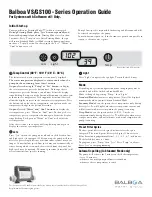
EN-14
452169.66.06 · FD 0009
www.glendimplex.de
English
LI 16I-TUR
7.5.3 Connecting an electronically
regulated circulating pump
Electronically regulated circulating pumps may have high start-
ing currents, which may shorten the service life of the heat
pump manager. A coupling relay must therefore be installed
between the output of the heat pump manager and the elec-
tronically regulated circulating pump. This is not necessary if
the permissible operating current of 2 A and a maximum start-
ing current of 12 A of the electronically controlled circulating
pump is not exceeded or an explicit release is in place from the
pump manufacturer. Further details can be taken from the elec-
trical documentation.
CAUTION!
!!
It is not permitted to connect more than one electronically
regulated circulating pump via a relay output.
8
Start-UP
8.1 General Information
To ensure that start-up is performed correctly, it should only be
carried out by an after-sales service technician authorised by
the manufacturer. These measures can also include an addi-
tional warranty under certain conditions (see Warranty).
8.2 Preparation
The following items need to be checked prior to start-up:
All of the heat pump connections must be established as
described in Chapter 6.
All valves that could impair the proper flow of the heating
water in the heating circuit must be open.
The air intake and air outlet paths must be clear.
The ventilator must turn in the direction indicated by the
arrow.
The settings of the Heat pump manager must be adapted
to the heating system in accordance with the controller’s
operating instructions.
Ensure the condensate outflow functions.
Both the accessories pack in the switch box and that which
is located under the ventilator must be removed.
8.3 Procedure
The heat pump is started up via the heat pump manager. Ad-
justments should be made in compliance with the instructions.
If an overflow valve is fitted to maintain the minimum heating
water flow rate, the valve must be adapted to the requirements
of the heating system. Incorrect adjustment can lead to faulty
operation and increased energy consumption. We recommend
carrying out the following procedure to correctly adjust the
overflow valve:
Close all of the heating circuits that may also be closed during
operation (depending on the type of heat pump usage) so that
the most unfavorable operating state - with respect to the
water flow rate - is achieved. This normally means the heating
circuits of the rooms on the south and west sides of the build-
ing. At least one heating circuit must remain open (e.g. bath-
room).
The overflow valve should be opened far enough to produce
the maximum temperature spread between the heating flow
and return flow listed in the following table for the current heat
source temperature. The temperature spread should be meas-
ured as close as possible to the heat pump. The heating ele-
ment of mono energy systems should be disconnected during
start up.
At hot water temperatures under 7 °C, start-up is not possible.
The water in the buffer tank must be heated to a minimum of
18 °C with the second heat generator.
To ensure a problem-free start-up, the following procedure is to
be implemented:
1) Close all consumer circuits.
2) Ensure that the heat pump has the correct water flow.
3) Use the manager to select the automatic operating mode.
4) In the special functions menu, start the "Start-up" program.
5) Wait until a return temperature of at least 25 °C has been
reached.
6) Now slowly reopen the heating circuit valves in succession
so that the heating water flow is constantly raised by
slightly opening the respective heating circuit. The heating
water temperature in the buffer tank must not be allowed
to drop below 20 °C during this process. This ensures that
the heat pump can be defrosted at any time.
7) When all heat circuits are fully open and a return tempera-
ture of at least 18 °C is maintained, the heat pump start-up
is complete.
CAUTION!
!!
Operating the heat pump at low system temperatures may
cause the heat pump to break down completely.
Heat source
temperature
Max. temperature spread
between heating flow and return
flow
From
To
-20 °C
-15 °C
4 K
-14 °C
-10 °C
5 K
-9 °C
-5 °C
6 K
-4 °C
0 °C
7 K
1 °C
5 °C
8 K
6 °C
10 °C
9 K
11 °C
15 °C
10 K
16 °C
20 °C
11 K
21 °C
25 °C
12 K
26 °C
30 °C
13 K
31 °C
35 °C
14 K
Summary of Contents for LI 16I-TUR
Page 2: ......
Page 22: ...DE 20 452169 66 06 FD 0009 www glendimplex de Deutsch LI 16I TUR ...
Page 69: ...www glendimplex de 452169 66 06 FD 0009 A XI LI 16I TUR Anhang Appendix Annexes ...
Page 70: ...A XII 452169 66 06 FD 0009 www glendimplex de Anhang Appendix Annexes LI 16I TUR ...
Page 71: ...www glendimplex de 452169 66 06 FD 0009 A XIII LI 16I TUR Anhang Appendix Annexes ...
















































